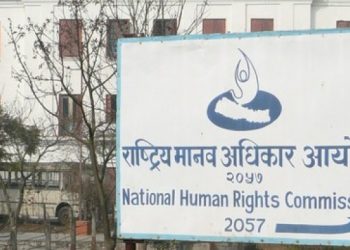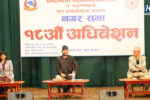KATHMANDU: Sri Lanka has reached a critical stage of economic bankruptcy.
The leadership of the Sri Lankan government has been criticized and boycotted by the people one after another, holding it (the authority) responsible for the crisis.
Looking at the incompetence of the Nepali political leadership, there is a growing concern that the situation in Nepal will be similar to that in Sri Lanka.
This has deepened the concern of Nepal’s socio-political personalities.
The governors, ministers, parliamentarians and leaders of Nepal Rastra Bank (NRB) have been reacting to the fact that the indicators of the country’s economy are moving toward a negative state.
This kind of comment has further deepened the deep crisis of the Nepalese economy. Seeing the problems of Sri Lanka in various media and social media, the screams of the citizens there, and the hours of taking diesel and petrol, it is natural to worry that the situation in Nepal will be the same.
The coronavirus impact on the economy is finally visible, lack of money in the market, lack of dollar reserves, declining remittances, a huge increase in petroleum products due to the Russia-Ukraine war, high cost of living, and imposition of an oil quota system reflect the visible impacts. They reveal the current reality of the country.
The main reason for such an economic crisis in the country now is high imports and low exports. That is, the country has an extreme trade deficit. In such a situation, what is the current monetary policy of Nepal Rastra Bank?
Serious debates and discussions are needed in various areas such as import substitution, agriculture and increasing production.
Similarly, everyone is waiting for the simplicity and ease in the field of investment of banks for increasing employment and expansion of industries and factories. In such a situation, the future monetary policy of Nepal Rastra Bank will determine the future of the country.
Economists are commenting that the budget that was made public on May 29 will not solve this crisis. Although the budget is good on average, the implementation side is very weak.
It is natural to have high hopes and expectations of the monetary policy of the central bank, which plays an important role in keeping the economy afloat and also in budget implementation.
This time, the meaning of politics and the finance minister-governor dispute is also in the spotlight. Finance Minister Janardan Sharma has resigned from the ministry post on the allegations that the tax rate has been manipulated.
Budget priorities, policies and programs included in the budgets of the local, provincial and federal budgets, and the targeted economic growth have to be addressed in the monetary policy.
Finance Minister Sharma, who once suspended NRB Governor Maha Prasad Adhikari, has stepped down the post.
Monetary policy is the policy formulated by the central bank to assist in the expansion of economic activities while maintaining macroeconomic stability. In other words, monetary policy is the method used by the central (Nepal Rastra Bank) bank to maintain the money supply system.
Since the promulgation of the NRB Act 2002, NRB has been making public its monetary policy every year since the fiscal year 2003-04.
Monetary policy aims to control interest rates and money supply on short-term loans and control inflation, maintain currency stability and maintain confidence in the nation’s currency. Monetary policy is made to control the money supply.
The monetary policy of any country is formulated by the central bank of that country. Monetary policy contributes to the expansion of economic activity while maintaining macroeconomic stability.
What should be the level of money supply in the economy then?
Monetary policy determines the area in which such money should flow or be consumed. The monetary policy keeps the country’s economy in balance by covering every sector of the economy.
Budget priorities, policies and programs included in the budgets of the local, provincial and federal budgets, and the targeted economic growth have to be addressed in the monetary policy.
It should aim to keep the price of petroleum products and inflation in the international market within the prescribed limits, to balance short-term interest rate inflation, inflation, black market and the impact on the economic system, liquidity management, inflation rate financial stability, unnatural investment control, increase in financial literacy, investment in productive sectors.
Everyone’s eyes are now set on the monetary policy hoping that the monetary policy will work to keep the country’s economy in balance by focusing on the implementation of loans for the poor and enterprising youth. For this, many organizations are now giving suggestions to the central bank.
In this regard, the Confederation of Banks and Financial Institutions Nepal (CBFIN) has put forward its suggestions at a press conference on Wednesday.
CBFIN suggested that the next priority should be to increase investment in agriculture and productive sectors.
According to Confederation President Pawan Golyan, continuing the government’s crackdown on imports of unnecessary and luxury items could stop the country from moving at the pace of Sri Lanka if banks could increase investment in agriculture and manufacturing.
Government priority
Stating that import substitution is a must, Golyan said that they have sent the same suggestions to the National Bank.
Expressing concern that the important data of the economy has been moving in a negative direction for some time now, the CEOs of various banks participating in the program said that the Ministry of Finance and Nepal Rastra Bank should immediately draw attention to it.
Bhoj Bahadur Shah, senior vice-president and spokesperson of the Confederation, said, “In order to prevent the declining economy from becoming more complex, the problems and challenges seen in the overall economy should be identified and monetary policy should be brought accordingly.”
From needles to toothpicks, from gundruk (dried green leaves) to meat, from carpets to expensive vehicles, maize, paddy, wheat, greens, potatoes, onions, and turnips have to be bought from outside, and the economy has to go through the burden of trade deficit.
In the suggestion sent to the NRB, CBFIN has said that the amount of the local body should be counted as a 100% deposit.
Other advice includes expanding investment in the productive sector and making special arrangements for remittance inflows to promote exports by continuing the tightening of imports of unnecessary and luxury goods.
Similarly, the Confederation believes that the situation can be made better by improving the business and business environment in the country and creating an environment conducive to productive industries in terms of credit from the banking sector to the private sector, as this will ensure there will be sufficient capital for industrialization in the country and contribute to reducing the trade deficit.
The Confederation has also suggested that focusing on medium industries, employment and export-oriented industries, infrastructure development and construction industries will increase the national product.
Likewise, CBFIN opines that banning the import of agricultural commodities and materials other than much-needed agricultural raw materials and expanding investment in the production of Nepali basic commodities can better the situation.
The Confederation’s suggestion includes promoting exports, giving special emphasis on utilization, discouraging wasteful spending and encouraging savings by discouraging the use of unnecessary goods and services.
These and similar important steps provided they are taken aptly by NRB, can improve the current economy of the country.
Even if such policies are included in the forthcoming monetary policy, there is no doubt that the economic crisis in the country can be warded off.
Economists say the current dollar in the country lasts for a maximum of 10 months. Then we may have to go at the pace of Sri Lanka.
From needles to toothpicks, from gundruk (dried green leaves) to meat, from carpets to expensive vehicles, maize, paddy, wheat, greens, potatoes, onions, and turnips have to be bought from outside, and the economy has to go through the burden of trade deficit.
Now, the loans given by NRB for cars and houses should be used in the agriculture and manufacturing sector. If banks invest in agriculture, manufacturing and tourism by curbing unessential and unproductive investments in this fiscal year, it will increase production and reduce imports.
Such investment will enhance employment. Therefore, the NRB should play a leading role in the implementation of such steps by clearly mentioning these things in the current monetary policy.









Comment